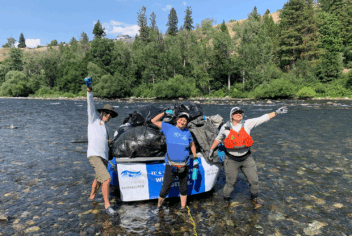In any negotiated agreement, each party should be liable for the things over which they have control.
Before you sign a contract, do you review it with your insurance broker?
Decision-makers at nonprofit organizations can better work with insurance brokers, identify potential problems with contracts, and navigate liability when signing a contract with local municipalities. The COVID-19 pandemic has created new challenges for nonprofit organizations around contractual liability. Fortunately, there are steps you can take to protect your organization and the communities you serve.
We always recommend that our members have someone with legal expertise review any contract before signing it. In this article, I’ll specifically cover issues of liability and indemnification in contracts.
How contract liability between nonprofits and municipalities has changed during COVID-19
Depending on how your nonprofit carries out its programs, a contract with your local municipality could cover anything from the work your nonprofit is doing for the community (for example, if you run childcare services or a food bank) to simply public space for a fundraising event (for example, a walk for the cure in a local park).
Even before COVID-19 became a public health concern, contract wording often pushed all liability onto the nonprofit, and in many cases, inappropriately so. That trend has continued. Immediately after COVID-19 emergency orders went into effect, we began to see wording being added to various contracts that shifted liability for any COVID-19 claims from the municipalities to the nonprofits. And for nonprofits that expanded their programming to assist their municipalities in COVID-19 relief efforts, we saw the addition of even broader language shifting liability onto those organizations.
Often, municipalities want the help from nonprofits to address issues in the community, but local government agencies try to pass off as much of the liability as they can to nonprofit partners as a way to control costs. So it’s important for decision-makers at nonprofits to understand what risks they are taking when partnering with municipalities, and to only agree to assume liability for things the nonprofit has control over.
Indemnification clauses
One of the main ways municipalities transfer liability is through the indemnification clause in the contract. This clause determines how the liability flows in case of a claim against the nonprofit or against the municipality.
An indemnity agreement is a risk transfer mechanism (a contract) in which one party (the indemnitor) transfers risk from (indemnifies) another party (the indemnitee).
What exactly does that mean in layman’s terms? The indemnification agreement attempts to ensure that liability for a claim is assigned to the party responsible for causing that claim, either through their direct action or through their negligence. Again, each party should be liable for the things over which they have control.
You want to make sure your nonprofit is covered in cases where there’s a claim from an error or omission on your part. Accidents happen and things are sometimes missed, which is why you buy insurance. However, you need to make sure you’re not being forced to cover someone else’s liability because of contract language that shifts others’ liability onto your nonprofit.
Here’s an example of a nonprofit project and a typical indemnification clause:
The city of Mos Eisley has a contract with the nonprofit Solo Foundation to set-up and manage COVID testing centers. Solo doesn’t do any of the testing nor do they handle any medical procedures or equipment. They simply setup the tents, direct traffic and check people in as they arrive. The city requires all of its contractors to include the following indemnification agreement in the Service Contract:
Consultant agrees to add the city of Mos Eisley as an Additional Insured and to hold harmless and indemnify the city of Mos Eisley, its officers, agents and employees for all claims, legal expenses or judgements which are caused by any negligence, liable act or omission of the consultant or those acting in the consultant’s behalf in the performance of your ongoing operations with respect to this contract.
A good contract would have mutual indemnification wording, where each party agrees to defend and possibly indemnify the other party for claims caused by their respective actions. Even considering the exposure to COVID claims, the above indemnification clause is fair. It references claims caused by the negligence of the nonprofit. This is not always the case in light of new liabilities like COVID-19.
By the end of 2020, both the reinsurance market and primary insurers started excluding or limiting coverage liability third party claims relating to the COVID-19 pandemic. In the case of a nonprofit, the vast majority of these third-party claims would be assertions that an individual contracted the virus because the nonprofit was negligent in taking precautions to mitigate the spread of the virus. This kind of claim would be difficult to prove, but it may leave your organization vulnerable to class action lawsuits, so it is important to work with your insurance broker to understand what kinds of expenses your nonprofit may be liable for under new insurance clauses.
Additional insured
An “additional insured” (AI) is a person or organization that enjoys the benefits of being insured under an insurance policy, in addition to whomever originally purchased the insurance policy (the named insured).
Here’s a real-life example:
A nonprofit hires a psychologist as a consultant to council its clients on-site once a week, in a group session. The psychologist requires, by contract, that the nonprofit add her as an additional insured on the nonprofit’s insurance policy. On the way to a meeting, one of the clients slips on a wet floor on the nonprofit’s premises and hurts their back. The client then sues the nonprofit and the psychologist as a result of the incident. As an additional insured, the psychologist would be defended by the nonprofit’s insurance policy.
Why would anyone want to be added as an additional insured? Because it helps to ensure that the party that’s liable for the loss holds the financial responsibility for a claim. As we’ve discussed, people should only agree to be responsible for the things over which they have control. In the case of our example above, the nonprofit should have been in control of keeping a safe environment by drying the floors. The additional insured (the psychologist) is being covered only for claims caused by the actions of the named insured (the nonprofit) to the policy.
An entity or person should only be added as an AI when there is some legal relationship between the nonprofit and that entity. In other words, if your organization is not being required by written agreement to add someone as an additional insured, you shouldn’t add them.
In some cases, the nonprofit will want to be added as an additional insured on another’s insurance policy. As an example, if the nonprofit has hired a contractor to do construction at the nonprofits location, it is a good idea to have that contractor, by way of a written agreement, add the nonprofit as an additional insured to the contractor’s insurance policy.
Arising out of vs. caused by
What makes an indemnification clause fair? There are a couple phrases the nonprofit should look for and try to avoid with respect to the indemnification clause. These phrases are “arising out of” and “sole negligence.” Here is the indemnification clause from our earlier example:
Consultant agrees to add the city of Mos Eisley as an Additional Insured and to hold harmless and indemnify the city of Mos Eisley, its officers, agents and employees for all claims, legal expenses or judgements which is caused by any negligence, liable act or omission of the consultant or those acting in the consultant’s behalf in the performance of your ongoing operations with respect to this contract.
Now, let’s change a few words:
Consultant agrees to add the city of Mos Eisley as an Additional Insured and to hold harmless and indemnify the city of Mos Eisley, its officers, agents and employees for all claims, legal expenses or judgements arising out of the performance of your ongoing operations with respect to this contract.
The first version states specifically that the claim must be caused by the nonprofit’s negligence. This is preferable, as the nonprofit should not accept liability for things outside their control. The second version is much broader in scope. It could be argued, inappropriately so, that any claim or loss that happens arises out of the nonprofit’s operations.
Here is a real-life claims scenario to illustrate that point (note that the names have been changed to protect anonymity of the organization):
Good Heart Housing leases apartments and houses to ensure the availability of low cost housing for their clients. They lease an apartment from Richard. Richard requires Good Heart to add him as an additional insured. In one of the apartments that Good Heart is using to house a family, there is a fire. The fire is caused by faulty wiring that Richard knew about but didn’t fix or tell Good Heart about.
It is clear that it was not the family’s or the nonprofit’s fault that the fire started. Should the nonprofit’s insurance (via the indemnification clause with “arising out of” wording) reimburse Richard for the loss?
Under the “arising out of” scenario, Richard could argue that this fire loss should be covered under the additional insured language because the fire was “arising out of” the nonprofit’s actions (renting the house). Under the “caused by” wording, it is clear that the fire was not caused by the actions of our insured (or the family). It was not the fault of either party that the fire started.
Sole negligence
Now let’s discuss the concept of “sole negligence.” Here is another example of a poor indemnification clause:
The Nonprofit agrees to indemnify, defend, and hold harmless The City, its agents, employees and officers, from any and all liability cost or expense, including but not limited to attorneys fees arising out of or relating to the performance of the work regardless of whether caused in part by the acts or omissions of the Nonprofit. Nothing herein shall be interpreted as obligating Nonprofit to idemnify The City against its sole negligence or willful misconduct.
Essentially, this clause means that if a claim is the result of the City being anything but 100% at fault, the nonprofit will be held responsible. In other words, let’s say the City is 99% responsible for a claim or The City can point to the sole negligence clause and try to push 100% of the liability onto the nonprofit. To make matters worse, it is very rare that a judge (or jury) would find either party 100% liable for any claim or loss. That is why some municipalities insist on this wording.
Nonprofits should push for better wording in contracts stating that indemnification for a claim will be allocated proportionally by the contribution of either party to that claim.
Top 3 ways to protect your nonprofit from additional liability
While COVID-19 presents a new risk for nonprofits in terms of liability, there are still fundamental best practices that can help protect your organization from taking on responsibility for events beyond your control. Here are three things you should look for in any indemnification clause for a contract you are going to sign:
- Make sure the wording refers to claims caused by your actions and not “arising out of” anything. The “arising out of” wording is too broad and could lead to liability being assigned to you that is out of your control. Don’t agree to take on liability for things outside your control.
- If you are agreeing to indemnify another party via a written agreement, ask that that party agree to also indemnify you (mutual indemnification). That way everyone is liable for the things over which they have control.
- You should ask that any “sole negligence” wording be removed. This type of wording will almost always lead to the indemnitor being responsible for all losses. Instead nonprofits should ask that indemnification for a claim will be allocated proportionally by the contribution of either party to that claim.
Before you sign any contract, it is always a good idea to have your broker review it to ensure your organization will be compliant with the indemnification and insurance clauses.





